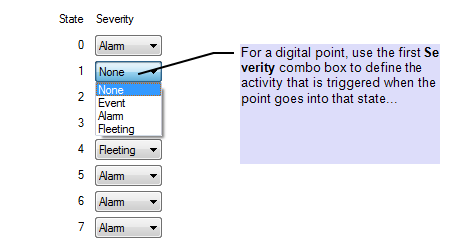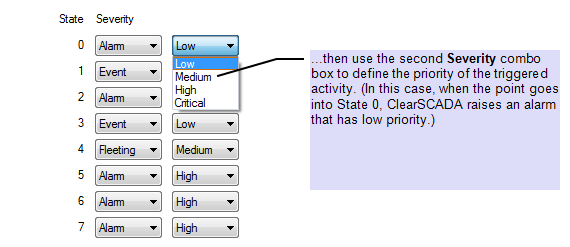In some instances, you can define whether ClearSCADA is to log an event or raise an alarm under specific circumstances. For example, you specify whether ClearSCADA is to trigger an alarm or event when a point enters a particular point state. (For more information on configuring point states and alarm limits, see the relevant ClearSCADA configuration documentation.)
You specify whether an alarm or event is to be triggered, by using the Severity fields on the appropriate Form. In this case, two Severity fields are displayed—one to define the type of activity that is to be triggered (for example, an event), and the other to define the priority for that activity.
Use the combo box on the first Severity field to display a list of severity types. Choose the option that you require:
- None—ClearSCADA does not generate any type of alarm or event when the item enters the relevant state.
- Event—ClearSCADA generates an event when the item enters the relevant state. Specify the priority of the event by selecting the required priority level from the adjacent combo box.
- Alarm—ClearSCADA generates an alarm when the item enters the state. Specify the priority of the alarm by selecting the required priority level from the adjacent combo box. This option is not available for the Normal state of a point.
- Fleeting—This option is only displayed when it is applicable, for example for digital point states. ClearSCADA generates a fleeting alarm when the item enters the relevant state. The fleeting alarm is deleted as soon as it is acknowledged by an engineer or operator. Specify the priority of the alarm by selecting the required priority level from the adjacent combo box.
The second Severity combo box does not display a ‘None’ option, as the box becomes ‘grayed out’ (unavailable) if ‘None’ is selected from the first Severity combo box.
The second combo box’s default options can be overwritten by a custom range of priorities. If the default settings in the second Severity combo box have been replaced by a customized range, select the appropriate level of importance. (For information on changing the default settings, see Alarm and Event Severities in the ClearSCADA Guide to Server Administration.)
NOTE: If the Dictionary feature is used on your system, strings in the second Severity combo box may be prefixed with @, in order for those strings to be replaced with other terms, when displayed in a List or on a Mimic, in ViewX. For more information, see Dictionary Settings in the ClearSCADA Guide to Server Administration.
Example:
The diagrams in this example show how the Severity settings might be configured for a digital point.

